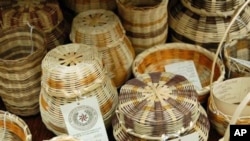In hard economic times, like the Great Depression of the 1930s, cash-poor Americans did what they could to make a living. Craftspeople found that durable, practical and beautiful handmade items were always in demand.
Something similar appears to be happening today, during what's being called the Great Recession. Americans are showing renewed appreciation for the value and beauty of handcrafted objects.
A Native American art cooperative that was born out of the Craft Revival of the Great Depression is now benefiting from the Great Recession.
Renewed appreciation
Business is good at Qualla Arts and Crafts in Cherokee, North Carolina, although you wouldn't think so from the sparse crowd browsing the store's native handcrafts.
Gone are the busloads of tourists dashing in to buy Indian beads and other cheap vacation souvenirs. In their place are serious collectors willing to pay premium prices for handmade native artwork.
According to Anna Fariello - an authority on Appalachian Art at Western Carolina University - the same thing happened during the early 1900s, as a nation of farmers evolved into a nation of factory workers.
"The nation then, you know, became a little nostalgic and began to look back at what they perceived of as a fading way of life," says Fariello.
Economic impetus
Largely untouched by the industrial revolution, the Appalachian region of the Southeastern United States became the focus of that nostalgia.
Suddenly, authentic mountain-made baskets, brooms, and bowls were all the rage in places like New York and Chicago. Social reformers and the government saw supporting local handcrafts as a path toward economic development in one of the nation's poorest regions.
"Part of the issue is that there were fewer jobs in the region and how could the government address that?" says Fariello. "And so, a lot of these small, private cottage industries sprang up and allowed young people to remain in the region and earn a bit of money."
That was Davy Arch's experience. The 52-year-old Cherokee artist's creations emerged directly from the common handcrafts of his childhood.
"We heated and cooked with wood, so wood lore and tool use was just a part of everyday life," he says. "And I started making utilitarian products like spoons and dough bowls and things like that when I was really young, probably six or eight years old, when I started just playing around with that kind of thing."
Protecting their heritage
Arch is a member of the Eastern Band of Cherokee Indians, which formed Qualla Arts and Crafts Mutual in 1946 in response to the increased interest in native handcrafts.
He says the Cherokee saw the Craft Revival as a way to make money while also protecting their heritage.
"Indigenous people all over are facing some of the same problems we are here, with losing their cultural identity because of assimilation into mainstream. So, this has been the hub of keeping a lot of traditions alive."
A good example is the Cherokee double-weave basket; an especially strong, basket-within-a-basket design. As far back as the 1700s, European explorers commented on the high quality of Cherokee baskets, but over the generations, the complex weaving technique was nearly lost.
"It got down to just three or four people being able to do that, and we held a class here at the Co-op and now there's about 30 people that can make those baskets," says Arch. "And I'd say about eight or 10 that are producing them for the resale market. So we've really, through the co-op here, and this extended community, revived and saved that art form."
Helping hand
The cooperative also helps members find the natural materials they need to create authentic art.
For example, they've begun noting the GPS coordinates of river banks where good potting clay can be found. The co-op had also started planting the increasingly scarce river-cane used in traditional basket weaving.
"It grows easily," says Tonya Carroll, Qualla Arts Outreach Coordinator, "but with all the development it's scarce and it's been hard to find and we've worked with them in order to locate areas it has grown to actually try to grow it."
Carroll says the Coop's efforts are paying off. A couple of Cherokee teens at the local High School have learned to make double-weave baskets.
"We have adults that find it complicated to do. So seeing those 16 and 17 year olds have those baskets that was just beautiful...they were woven tightly and the designs were very complicated and I was just blown away."
Fariello, who directs The Craft Revival Project at Western Carolina University, agrees that the cooperative is more than an art gallery.
"The fact that an organization like Qualla Arts and Crafts has this lengthy history, speaks to their success in terms of creating a sustainable organization to, in fact, sustain these traditions."
The market for handcrafts may ebb and flow, but Fariello says organizations like Qualla Arts ensure that traditional crafts - and the skills to create them - will be around whenever Americans start to grow nostalgic for them again.
(Click below to hear Davy Arch discuss his art.)















